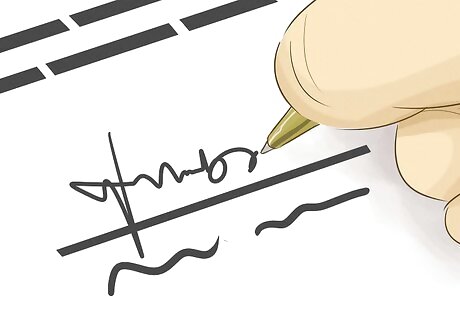
views
Determining What Type of Deed You Need

Know what a deed is. A deed is a legal document that transfers ownership in property from one individual to another. There are different types of deeds you can prepare depending on who you are transferring the property to and how much you want to protect the party getting ownership. A deed must be in writing and must contain certain information in order to be valid.

Consider a general warranty deed. Before you prepare the deed, you need to figure out what type you will use to convey your property. One option is the general warranty deed. A general warranty deed conveys the property in question, as well as a number of covenants of title. These covenants are promises by the seller ("grantor") to the buyer ("grantee") that the grantor is transferring their entire interest in the property to the grantee. A general warranty deed guarantees against any acts or omissions on the grantor's part or on the part of any predecessors (i.e., previous owners) that might undermine the quality of the title. If you are using a general warranty deed to convey your property to a grantee, you are making the following promises: You, as the grantor, are promising that you are the lawful owner of the property at the time of conveyance; You are promising that the property is free from all encumbrances; and You are promising to defend the title so that the grantees can enjoy peaceful and quiet possession of their property. Consider using a general warranty deed when you are selling property to someone unfamiliar to you. Buyers will generally not accept anything less if they do not know who they are buying the property from. Use a general warranty deed only when you feel comfortable with the property's ownership history, because you will be responsible for protecting the new owners if a problem from the past comes up.

Think about a special warranty deed. A second deed option, the special warranty deed, is similar to the general warranty deed. However, you are only promising to protect the title against defects that arose through your own acts or omissions. In other words, if you use this type of deed, you are not warranting against defects or claims that arose before you acquired ownership of the property. You can use a special warranty deed when you are selling property to someone unfamiliar to you. While some buyers may be wary because you are not using a general warranty deed, others will be content getting the protections offered by a special warranty deed. Use a special warranty deed when you don't feel comfortable with the property's history before your period of ownership.

Know about the quitclaim deed. The third deed option, the quitclaim deed, transfers any ownership interest you may have in the property. However, it does not make any promises about what that interest is, if any. Quitclaim deeds are often used to clear up title problems, to transfer property between spouses, or in informal transactions involving family or friends.
Preparing the Deed

Identify the grantee. After commencing an action to transfer your ownership interest in a piece of property, whether by selling it, gifting it, or transferring it at death, you will need to prepare a deed. The first requirement of a valid deed is a satisfactory identification of the grantee, which is the person getting title to your property. In general, you will need to include their name only. In some states, you will be required to include their address and other identifying information as well. The grantee can be one or more persons, a corporation, nonprofit, or any other entity. For example, your deed might identify the grantee in the following way: "This general warranty deed made and entered into on this ____ day of _______, _____, for the consideration of $______, and other valuable consideration, the receipt and sufficiency of which is hereby acknowledged, ______________ (hereinafter "Grantors"), hereby warrants to ______________ (hereinafter "Grantees")..."

Identify the grantor. A valid deed must also identify the grantor, or the person transferring ownership of the property. In general, you will only need to include their name. The grantor can be one or more persons, a corporation, a limited liability company, or any other entity. For example, your deed might identify the grantor in the following way: "This general warranty deed made and entered into on this ____ day of _______, _____, for the consideration of $______, and other valuable consideration, the receipt and sufficiency of which is hereby acknowledged, ______________ (hereinafter "Grantors"), hereby warrants to ______________ (hereinafter "Grantees")..."

Provide a description of the property. After identifying the parties you are required to describe the property at issue. This description must be sufficient to identify the property for legal purposes. The best place to find the legal description is on the most recent deed to the property (the one that conveyed the property to the current owner). The legal description should be preceded by words such as "described as follows." Descriptions found in property tax records, as well as street addresses, are not legally sufficient and should not be used. There are usually two types of legal descriptions you should use: Lot and block descriptions, which are most often used in subdivisions. It will most often refer to a lot, the block number, the subdivision name, and the county and state. For example, a lot and block description may look like this: "Lot 9, Block 58, Scott Lake Manor Section 8, according to the plat thereof, as recorded in Plat Book 65, at page 117 of the public records of Miami-Dade County, Florida." Metes and bounds descriptions, which are most often used for non-subdivision property. This type of description identifies the property within a public surveying system. The boundaries are then described by working around a piece of land, starting with the "point of beginning." For example, a metes and bounds description might look like this: "Commence at the NE corner of the East 1/2 of West 1/2 of NE 1/4 of SW 1/4 of Section 17, Township 1 North, Range 12 West and run South 0 degrees 03'08" E, 28 feet to the South right of way line of Silver Lake Road and the point of beginning; thence continue S 0 degree 03'08" E, 409.67 feet; thence N 89 degree 54'41" W, 314.69 feet to the East line of a 20 foot easement..." This description would continue until it gets back to the point of beginning.

Include words of conveyance. All deeds are required by statute to have words of conveyance included within the document. Words of conveyance show the grantor's intent to transfer title to the grantee. The words of conveyance will differ depending on what type of deed you are using. For example, if you are using a quitclaim deed, your words of conveyance may be "convey and quitclaim." If you are using a general warranty deed, your deed may read "convey and warrant." Finally, if you are using a special warranty deed, you may insert "convey and specially warrant."

Sign the document. A valid deed must contain the signature of the grantor. There is no requirement that the grantee sign the deed as well.
Executing the Deed

Acknowledge the deed. Once the deed has been prepared, you will need to have it acknowledged if you want to record it. An acknowledgement is a statement that the deed was actually signed by the person whose signature appears on it. In most cases, an acknowledgement will be performed by a notary who can certify the signature on the deed. If you are the grantor, do not sign the deed until you are in the presence of the notary.

Deliver the deed. A deed is of no effect and is not valid until it is delivered. In this context, delivery means much more than simply handing the deed to the grantee. The grantor must have the intention, at the time of delivery, to pass title immediately. This intention is not present, if, for example, you give a deed to John but you tell him not to record it until you die. Delivery will be presumed if the deed is found in grantee's possession or if the deed has been recorded. However, this presumption is rebuttable. The deed will be presumed to have been delivered as of the date on the deed.

Accept the deed. When the grantor validly delivers the deed, the grantee must accept it. Acceptance can be shown by words, acts, or conduct of the grantee showing their intent to accept. For example, a deed will be considered accepted if you, the grantor, hand a valid deed to Debbie and Debbie shouts, "I accept your conveyance."
Recording the Deed

Visit your county recorder's office. The act of recording serves the purpose of notifying subsequent buyers and people with claims against the property that ownership has been transferred. To record a validly prepared and executed deed, you will need to take the deed to the county recorder's office in the county where the property is located. The name of this office may vary, depending on what state you live in. It may be called the land registry office, registrar of titles, or register of deeds.

File the deed. Once you arrive at the county recorder's office, you will file the deed with the clerk. The clerk will take the original deed and will give it a book and page number according to the piece of property at issue. The clerk will then file the deed in both a grantor and grantee index.

Pay the required fee. When you record your deed, there will be a required fee. In most states, the fee will be based on how may pages you are filing. For example, in Palm Beach County, the first page costs $10.00, with each additional page costing $8.50.



















Comments
0 comment